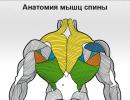Biathlon overall standings. "Save a point." How do cup points count in biathlon. How are they selected for the mass start
Since 2008, fans have already become accustomed to the existing scoring system, where 60 points are given for winning each race, 54 for second place, 48 for third, and further down. Total points get 40 top athletes or teams, so in the mass start and relay they go to everyone who made it to the finish line. Teams that have been lapped and eliminated also receive a finishing position and points.
All individual races of the season (minus the two worst starts) go to the final standings of the World Cup, as a result of which the winner of the overall standings receives the Big Crystal Globe, and the winners of the standings in individual disciplines (sprint, pursuit, individual race, mass start, relay races and mixed relays) - small cups. World Championship races are judged in the same way as regular World Cup starts. In case of equality of points in the overall standings, the participant with more victories is higher.
However, this was not always the case. The first World Cups from 1977 to 1984 awarded points to athletes who took places from 1st to 25th, and points were awarded in reverse order- from 25 to 1. In this scenario, the victory in the overall standings was won not by the strongest, but by the most stable or the one who had more starts. Since 1984, 30 points have already been given for a victory, and since 2000 - 50 and award the top thirty athletes.
What is the Nations Cup for?
The Nations Cup score, which is counted separately for men and women, includes only individual, sprint and relay races, and points are awarded in a special way. In the "individual" and sprint, the points results of three the best biathletes from the country, and points for the relay go on a special scale: 420 for first place, 390 for second, 360 for third, and so on. The last 30th place gives only 20 points to the piggy bank. In the mixed relay, half of this amount goes to women, and half to men,.
First of all, the Nations Cup determines the number of athletes that a country can enter to start in the Cup and World Championships. The top five countries receive a quota of six athletes in the World Cup. At the World Championships, the top 15 countries from the previous season can enter four athletes per race, not counting last year's World Championship or Olympic winners, who are eligible to start outside the quota. Teams that take places from 16th to 25th can nominate three participants, from 25th to 30th - two and 10 more countries - one at a time.
In addition to qualifications, the Cup of Nations at the end of the season is awarded to the team's senior coach in the form of a crystal globe. The trophy itself is less prestigious than the individual World Cup, and shows the general level of development of biathlon in the country rather than the real success of the team. In accordance with the Nations Cup, 30 teams are also selected to participate in the classical and mixed relay, however, in practice, the number of teams rarely exceeds the limiting thirty.
How are they selected for the mass start?
Coaches and athletes also have to count points during the World Championship, since the starting list of the mass start - the final personal race of the championship - depends on them. Half of the 30 starting places in the mass start are occupied by the top 15 athletes in the overall World Cup standings, then the winners in the sprint, pursuit and individual race are added to them, who did not fall into their number. Finally, the remaining places are distributed according to the points scored at the World Championship in the previous three races. In practice, an athlete who consistently hits the top ten at the World Championships gets into the mass start, even if things were not going well for him during the season.
There is also a maximum limit of four athletes for each team in the mass start, with only two exceptions. Firstly, as already mentioned, last year's champion can start outside the quota and automatically get the 30th start number if he did not qualify for any of the criteria. Secondly, if a country has more than four winners of individual races, then all of them have the right to start.
And most importantly, unlike the Olympics, they count towards the World Cup, which means that in addition to the fight for medals, in Kontiolahti we will follow the confrontation in the fight for crystal globes Martin Fourcade, Anton Shipulin And Simona Schemppa in men Daria Domracheva And Kaisa Mäkäräinen- among women.
The World Cup is an annual competition in biathlon, the results of which determine the best biathlete and biathlete of the season. Calculated by summing up points earned in World Cup races. . The rules for including results in the overall World Cup standings have also changed.
IN season 2017/2018 the two worst results of each athlete are not taken into account in the overall World Cup standings. If the athlete did not start, did not finish, or was disqualified, this is also recognized as the worst result. Race results Olympic Games are not included in the overall World Cup standings.
Competitions included in the overall World Cup standings.
World Championship races are included in the calculation of the overall World Cup standings since 1995.
The races of the Olympic Games were included in the calculation of the total World Cup standings in 1998, 2002, 2006 and 2010. Since the Olympics in Sochi, olympic racing are not included in the overall score.
Rules for subtracting the worst results from the calculation of the overall World Cup standings.
The race from the general start is one of the most spectacular disciplines in biathlon and at the same time the most mysterious in terms of composition. How to earn the right to run a mass start at the 2016 Biathlon World Championships? What is the Nations Cup and why is it needed? Why are there two Swedes in the starting protocol of the World Cup and, for example, Nadezhda Skardino? See, consider..
The strongest or the most stable?
Since 2008, fans have already become accustomed to the existing scoring system, where 60 points are given for winning each race, 54 for second place, 48 for third, and further down. In total, the top 40 athletes or teams receive points, so in the mass start and relay they go to everyone who made it to the finish line.Teams that have been lapped and eliminated also receive a finishing position and points.
All individual races of the season (minus the two worst starts) go to the final standings of the World Cup, as a result of which the winner of the overall standings receives the Big Crystal Globe, and the winners of the standings in individual disciplines (sprint, pursuit, individual race, mass start, relay races and mixed relays) - small cups. World Championship races are judged in the same way as regular World Cup starts. In case of equality of points in the overall standings, the participant with more victories is higher.
However, this was not always the case. The first World Cups from 1977 to 1984 awarded points to athletes who took places from 1st to 25th, and points were awarded in the reverse order - from 25 to 1. In this situation, the victory in the overall standings was won not by the strongest, but by the most stable or the one who spent more starts. Since 1984, 30 points have already been given for a victory, and since 2000 - 50 and reward the 30 best athletes.
What is the Nations Cup for?
The Nations Cup score, which counts points for men and women separately, includes only individual, sprint and relay races, and points are awarded in a special way. In the “individual” and sprint, the results of the three best biathletes from the country are taken into account, and the points for the relay are on a special scale: 420 for the first place, 390 for the second, 360 for the third and so on. The last 30th place gives only 20 points to the piggy bank. In the mixed relay, half of this amount goes to women, and half to men, and in the super mix, a quarter falls into each of the piggy banks.First of all, the Nations Cup determines the number of athletes that a country can enter to start in the Cup and World Championships. The top five countries receive a quota of six athletes in the World Cup. At the World Championships, the top 15 countries from the previous season can enter four athletes per race, not counting last year's World Championship or Olympic winners, who are eligible to start outside the quota. Teams that take places from 16th to 25th can nominate three participants, from 25th to 30th - two and another 10 countries - one at a time.
In addition to qualifications, the Cup of Nations at the end of the season is awarded to the team's senior coach in the form of a crystal globe. The trophy itself is less prestigious than the individual World Cup, and shows the general level of development of biathlon in the country rather than the real success of the team. In accordance with the Cup of Nations, 30 teams are also selected to participate in the classic and mixed relay races, but in practice the number of teams rarely exceeds the limiting thirty.
How are they selected for the mass start?
Coaches and athletes also have to count points during the World Championships, since the list of athletes in the mass start, the final personal race of the championship, depends on them. Half of the 30 starting places in the mass start are occupied by the top 15 athletes in the overall World Cup standings, then the winners in the sprint, pursuit and individual race are added to them, who did not fall into their number. Finally, the remaining places are distributed according to the points scored at the World Championship in the previous three races. In practice, an athlete who consistently ranked in the top ten at the World Championships gets into the mass start, even if things were not going well for him during the season.There is also a maximum limit of four athletes for each team in the mass start, with only two exceptions. Firstly, as already mentioned, last year's champion can start outside the quota and automatically get the 30th start number if he did not qualify for any of the criteria. Secondly, if a country has more than four winners of individual races, then all of them have the right to start.
And most importantly, since 1995, all World Cup races, unlike the Olympics, count towards the World Cup, which means that in addition to the fight for medals, in Holmenkollen we will follow the fight for crystal globes. Since last season, points in the mass start are counted in a new way. Participants who take places from 21st to 30th receive them in the form of a regression, and 30th place gives only two points, instead of 11.
Alexander Kruglov,






